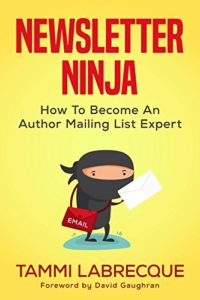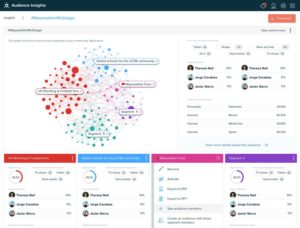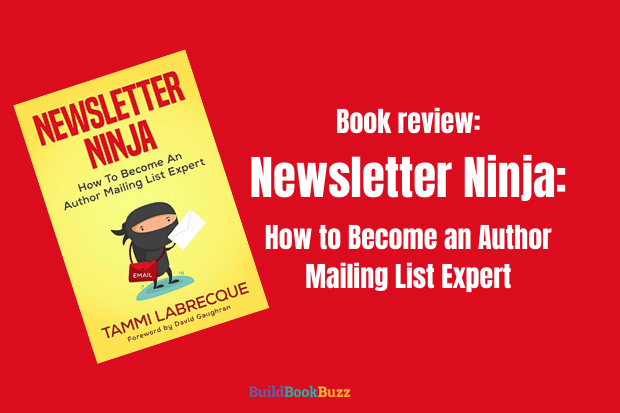Book review: Newsletter Ninja: How to Become an Author Mailing List Expert
Affiliate Disclosure: This post contains Amazon Associate links, which means if you click on them and make a purchase, I will receive a couple of pennies (at no extra charge to you).
I’d love to see more of you use email marketing to build relationships with readers in a way that will help you sell more books.
As with just about every book marketing tactic, there’s a right way and a wrong way to use email marketing as an author. And, not surprisingly, it’s not as simple as finding someone who knows how to add an email form to your website.
You also need to know how to encourage people to add themselves to your list, and you have to send email messages that “speak” to them.
That’s why I’m reviewing Newsletter Ninja: How to Become an Author Mailing List Expert by Tammi Labrecque. I think it will help with nearly every aspect of author email marketing.
Who will find this book helpful?
Newsletter Ninja will help authors at several different knowledge levels. They are people who:
- Aren’t convinced it’s a smart marketing tactic
- Know they should do it, but don’t know much more than that
- Make building an email list a priority and send a regular newsletter
- Are more experienced email marketers, but know they can learn more about how to use it even more effectively
The book covers everything you need to know and understand about using email marketing as an author with one exception. It doesn’t show you how to get set up with an email collection form on your website.
That’s because the process isn’t uniform. It varies for each email service provider, so you’ll need to use your provider’s tutorials and support staff for that. (If you’re not a do-it-yourselfer, ask a friend to recommend someone who can do it for you.)
What you can expect from Newsletter Ninja
 There’s a lot to like about this book, including the author’s friendly, conversational tone. She’s an excellent writer, which makes it easy to learn from her.
There’s a lot to like about this book, including the author’s friendly, conversational tone. She’s an excellent writer, which makes it easy to learn from her.
There’s something for every author in this book, no matter where you are in the spectrum. Not using email at all? She’ll talk you into it. Power user? You’ll love the last few chapters about re-engagement and split testing.
If you’re using email marketing already, you’ll learn how to do it better — and you’ll learn how to become a more sophisticated user, too.
One of the beauties of this book’s contents is that you can stop reading as soon as you feel like you’re getting in over your head. Use what you’ve learned to improve what you’re already doing. Then, with that mastered, come back to the book and read more about what is, for you, next-level author email marketing.
Throughout the book, Labrecque makes it clear that she knows that not everyone understands industry buzzwords. She defines many of the terms she uses, such as “cookie” (what she calls that incentive you offer readers in exchange for their email address), and “onboarding sequence.”
This is important because if you get confused by or hung up on the buzzwords, you might stop reading. The author brings you along with her gently, all the while reassuring you that she is in tune with you. I like that!
A few gems
I’m sure it’s not surprising that I like a book that repeats some of the things I tell the authors I coach. One of these is in Chapter 1: “Do not make business decisions based on your own consumer behavior.” You are not your reader, she reminds us.
In Chapter 4, she tells us that the primary purpose of an author newsletter isn’t to sell books. It’s to build superfans. With those superfan relationships in place, you’ll sell books, but you don’t want to reach out to your subscribers only when you’ve got a new book for them to buy.
In Chapter 7, Labrecque explains the newsletter triad: you want your subscribers to open, click, reply.
If you’re sending a newsletter, is that happening for you? Do you know what percentage of your messages get opened? Are subscribers clicking on your links? Are they replying to your messages? If not, Newsletter Ninja will help you fix that.
Labrecque also offers an extensive list of helpful links to more information online, taking your learning outside the pages of her book to other websites.
For fiction and nonfiction authors alike
I was surprised to discover that in this book, Labrecque focuses on fiction, with no reference to nonfiction authors — at least none that I could find. The book’s description doesn’t say it’s specifically for fiction writers, and that’s not clear from the table of contents, either.
Even so, we nonfiction authors are smart enough to see past the fiction examples and stories and focus on the valuable lessons, regardless of how they’re packaged. You will learn as much as any novelist — you just won’t have the “for instances” that could help bring the concepts to life for you.
One topic that’s fiction-specific and less helpful to nonfiction authors is the Chapter 11 discussion about what to give fans to encourage them to sign up for your newsletter. Labrecque’s suggestions — a novella or prequel, for example — let readers sample the author’s writing.
I’d recommend considering other, more creative options, in light of recent research suggesting that short-form content works best. Labrecque did offer a few non-writing-sample alternatives, and I encourage you to consider that approach, too, whether you write fiction or nonfiction.
Two thumbs up
In college course terms, this book starts out at the 101 level, moves to 201, and ends at 301. You might not be comfortable moving through all levels right now. If you’re a beginner, start with the basics before implementing more sophisticated tactics.
You’ll want to know everything in the book eventually, but it’s OK to learn at your own pace.
I highly recommend Newsletter Ninja: How to Become an Author Mailing List Expert. I’m excited about implementing some of the ideas I got from it, too!
Are you using email marketing? Are you getting the results you want? Tell us about it in a comment!
Tip of the Month
 I like to share a “Tip of the Month,” a free resource or tool for authors, on the last Wednesday of the month.
I like to share a “Tip of the Month,” a free resource or tool for authors, on the last Wednesday of the month.
This time it’s a Audiense.com, a fascinating tool that helps you understand your audience’s demographics. It will help you learn more about your readers and, in turn, discover where to reach them online.
At Audiense.com, scroll down to the “Unique audience segmentation” section and click on “create a free report.”
After adding a name for your report, you’ll define your audience. This is done with Twitter accounts and hashtags. Add the “@” accounts followed by your ideal readers, but also add the hashtags you believe are relevant to them.
In a few hours, you’ll get a report with insights about your audience that you can use to help determine which social media platforms will work best for you or to guide your Facebook advertising audience choices. Be sure to click on all the tabs to get the most from it.
You can generate three reports a month.
Like what you’re reading? Get it delivered to your inbox every week by subscribing to the free Build Book Buzz newsletter. You’ll also get my free “Top 5 Free Book Promotion Resources” cheat sheet immediately!


OMG!! This seriously is the most amazing Tool! You REALLY need to read this and use it and do everything it says! I HIGHLY recommend this
I love that endorsement!
Sandy
Thanks Sandra for another great article. My main struggle with email lists and the whole funnel thing is that despite regular, good downloads of my permafree book, the first of the series, that links to my landing page, something is blocking the expected clicks on that page – people can get the second book in the series for free, having read the first one as permafree, yet I’m not getting subscribers. It’s not a technical issue (I’ve checked) so I don’t understand what I’m doing wrong. I’m looking for ways to get help for this!
To make sure I understand: People get the first book free via Amazon or elsewhere. In that book, you offer a second free book if they click through on the link provided and sign up for your newsletter?
Sandy
Thats right! I know the books are good because they have great reviews, including 5 stars from Readers Favorite. I suspect I haven’t found my audience though, that’s probably the issue.
I’m not a big fan of using a book as a lead magnet, so I’d encourage you to create something else that’s short and relevant — a character guide, a map of fictional region for a series, etc. It’s an opportunity to be creative.
Sandy
Thanks Sandy, good advice! I’ll have rethink about the funnel strategy.
Here’s another thought, Alan: People who downloaded the book because it’s free might not have even read it. I have quite a few downloads on my Kindle that I haven’t read yet, and I’m not unique. These are books I intend to read, but others also download something just because it’s free, even if it’s not the type they usually read, etc.
You really want to be driving readers to your opt-in page in other ways — not just through your perma-free book. If you aren’t doing that already, give that a try before abandoning what you have now.
Sandy
I haven’t published yet, but I plan to use email marketing to announce new releases. I signed up for Pinterest to use it as a fan site and Instagram to document my progress. I haven’t planned on using social media as marketing, just for interaction and providing content to readers. I do plan on doing email marketing once I really get started. I don’t know if it’ll work for me but I think mailing lists are great sales tools.
It’s never too soon to start collecting email addresses, Ashley! If you start now, you’ll have a list to email when you can announce the first book. Your thoughts?
Sandy
That sounds like a great idea.
I happen to have sent out an email to my list just before reading your message linking to this review. My open rates are decent (and super high when I send to a subset of beta readers or launch team members). But I’d like to grow my list and find ways to make subscribing more valuable for my readers.
It’s too bad that the book focuses only on fiction, but it still sounds useful.
Everything in the book applies to both nonfiction and fiction — it’s just that all the examples are for fiction. I read it as a nonfiction author and can reassure you that it’s directly relevant to my work. And honestly, I think it’s easier for nonfiction authors to provide useful newsletter content than it is for novelists, so you’ve got that going for you!
Sandy
Thank you, Sandra (and the universe) for this book resource. I started an email list a few months ago by offering a 10-lesson writing ecourse I had created for a platform. But I’ve been agonizing over what to send out on a regular basis. The pressure is mounting as the weeks and months go by. Aghhh. I want to provide value to people because as someone said to me recently, it’s not a list it’s an audience of people.
“It’s an audience of people” is brilliant! Thank you for sharing that.
I just visited your website to see what you write about. Why don’t you pretend you’re one of your clients and offer content advice to yourself? I know that might sound silly, but I’m serious. If a client was paying you for advice about what content to put in a regular newsletter, what would you suggest they do? Also, I think regular how-to tips might be a good fit for you. And if you don’t already, subscribe to your competitors’ newsletters and see what they send people. Subscribe to A LOT of newsletters to see what they send people!
And I love that you offer your subscribers an e-course. What a great idea!
Sandy